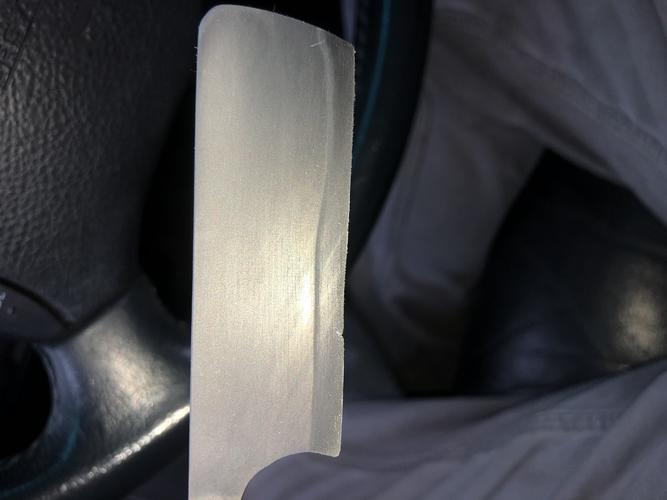Results 11 to 18 of 18
Thread: Two questions from a newbie
Hybrid View
-
03-25-2020, 03:22 AM #1

Leave yourself like .06”at the edge. I grind everything else pretty close. I leave like an extra .015” around the whole blade before heat treat. Post heat treat I like to take the edge down to about .005” and set the bevels. Make sure to apex the edge. This will show you where your grinding isn’t consistent. You can finish grinding down to almost no bevel, you’re looking for something thin like .03” or less. Another technique one of the members here showed me was to grind the edge down to where it starts to foil, then cut your bevel. I have only tried that a couple of times but have yet to get the feel for it.
-
The Following User Says Thank You to jfk742 For This Useful Post:
spazola (03-26-2020)
-
03-28-2020, 12:36 PM #2

I grind literally to foil before going to the hone. Joe Calton checked my work with calipers though I don't remember how thin it was. All I remember is that it was consistent thickness along the entire edge.
There is this video of me on youtube, from a couple years ago at the TX meet.
Til shade is gone, til water is gone, Into the shadow with teeth bared, screaming defiance with the last breath.
To spit in Sightblinder’s eye on the Last Day
-
03-28-2020, 01:48 PM #3Junior Member

- Join Date
- Mar 2020
- Posts
- 5
Thanked: 0
Well I had some uh-oh moments on the two I started on. The first one I burned the edge slightly and ruined. On the second one I though everything was going well but I got the area behind the edge too thin and got a small crack. I must have taken my hollow too deep on that one. I learned a few things that I can apply on the next ones so not a total loss.
-
03-28-2020, 04:27 PM #4

-
03-31-2020, 12:06 AM #5

You can get about 13/16” out of a 6” wheel, edge to spine without going too thin above the edge. I use a 6” for rough grinding, and a 4” and sometimes down to a 2” to hog off material before heat treat. I’ll run the 6” up to about 3/4” above the edge to a parallel scribed line that follows the spine. After heat treat I’ll run the 6” down to finish thickness at the edge. As I get close I run up the grits as well as push the spine/hollow junction up .0625-.125” as I’m finish grinding. That just gets me prepared to step down to a 4” wheel. I do the same process until the grind at the edge side of the hollow begins to blend with where I left off with the 6”. I then run through the grits making sure everything blends well. If you want to go past a 1/2 hollow then do the same thing with a 3” wheel, 2”- 1 3/4” for full hollow. Most the blades I’ve made have been 7/8- 8/8.
Make sure you’re using sharp belts for post ht grinding, then use new belts when finishing. I trashed a few blades I put too much heat into because I using used belts that still “felt” sharp, I should have been using new belts. The added pressure to get a used belt to cut causes undulations in the finish, not to mention the grit is usually unevenly worn, then there’s the heat generated. Any cost savings from using belts too long is quickly lost in the extra time hand sanding or fixing bad grinds from uneven belts.
Definitely try Bruno’s technique of foiling the edge. He showed it to me in person but he covers everything he showed me, in the video. The technique I laid out was shown to me by Victor of Bluesman Blades.
-
The Following User Says Thank You to jfk742 For This Useful Post:
Permarcustomknives (04-01-2020)
-
04-01-2020, 01:17 AM #6Junior Member

- Join Date
- Mar 2020
- Posts
- 5
Thanked: 0
I tried again, this time using my 10” wheel instead of the 4” is was using before. Was way more forgiving. I guess that would be considered a near wedge. I got it done to about 3 thou and I got a bit scared to go any further. So I guess I’ll spend some time on the stones to get a feel for the geometry.

Also my first try at a hamon, not a ton of activity and I over etched it a little but I’m happy with it for my first time.
-
04-09-2020, 06:43 PM #7

As always, I'm a little late to the party. In response to the original question, I grind my edges to 0.030" thick before heat treatment. After heat treatment, I start with 60 grit and grind to about 0.001" or slightly less, and 220 grit. Then, I set my honing bevel. After the honing bevel is set, I even things up with 400 and 800 grit as some of the guys stated above. After heat treatment, all grinding is done wet.
-
The Following User Says Thank You to Tim Zowada For This Useful Post:
spazola (04-09-2020)


 45Likes
45Likes LinkBack URL
LinkBack URL About LinkBacks
About LinkBacks






 Reply With Quote
Reply With Quote



